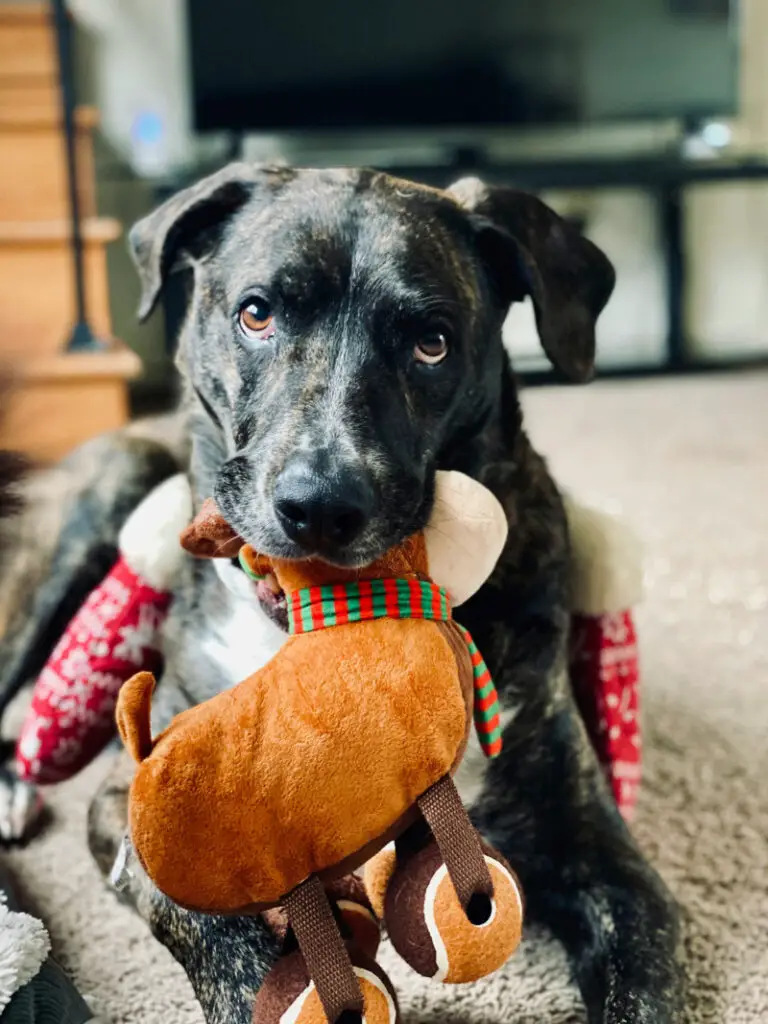The growth of bumps and tumors in dogs is a fairly common condition. These tumors can appear at any stage of life but are usually more frequent in adult or elderly dogs.
Concerned about the presence of a mass or lump on your pet’s body? As an owner, it is important that you know what types of tumors in dogs appear, what causes them, what symptoms help to identify them, and what consequences they have for the animal’s health.
Note. Although the information addressed in this article comes from specialized sources in veterinary medicine, its content is for educational and informational purposes only. In no case is it intended to replace or contradict the opinion and diagnosis provided by your veterinarian.
Table of Contents
What are canine tumors and cysts?
According to the American Veterinary Medical Association and other specialized sources, tumors are masses or lumps created by the abnormal and uncontrolled growth of certain cells/tissues. The medical term for these lumps is neoplasms.
Just like in people, tumors in dogs can be benign or malignant. Benign tumors tend to grow slowly; Although they cause displacement, they do not invade the surrounding tissues, nor do they spread throughout the body.
In contrast, malignant or cancerous tumors are often unpredictable. Some grow slowly, while others grow quite quickly. They can invade surrounding tissues and spread to other parts of the body.
The word “tumor” is commonly used to refer to an unknown lump, cyst, or growth. However, most veterinarians avoid using the term without first obtaining a specific diagnosis.
Although some types of dog tumors are associated with cancer in dogs, it is important to note that not all tumors are cancerous.
What causes tumors in dogs? Main risk factors
Many owners wonder: what can cause a tumor to appear in their dog? As we mentioned before, tumors are caused by the abnormal growth of certain cells or tissues in the body. But what causes such growth in the first place?
In general, these are the main risk factors to consider:
- Size and weight. Large dogs and those that are overweight are more prone to tumors.
- Age. Cysts and tumors are common in dogs over 6 years of age. They are less common in puppies and young dogs.
- Diet. There is some evidence that high-carbohydrate diets encourage the greater growth of bulges and masses.
- Sun exposure. Working dogs and those with thin or pale coats are at increased risk of developing skin tumors and cancer.
- Race. It appears that some breeds of dogs are more likely than others to develop tumors.
- Environmental factors. Different studies have found that exposure to environmental carcinogens (cleaning products, herbicides, paints, industrial chemicals, etc.) plays an important role in the development of abnormal growths.
- Hormonal and genetic disorders. Another common cause is a hormonal imbalance caused by pregnancy in female dogs, or by the use of certain medications.
- Immunity. A dog is more prone to tumor growth if it has a weakened immune system.
- Genetic predisposition. Some dogs may have a certain predisposition to health problems that are characterized by the formation of tumors.
Some lumps and cysts can also develop as a result of infection, an inflammatory reaction, or injury.
What are the most common types of dog tumors?
There is a wide variety of benign and malignant tumors that can affect dogs. Some look like small bumps under the skin, but others can grow into large lumps on the pet’s body.
The 11 most common types of dog tumors are:
- Sebaceous cysts, adenomas, and adenocarcinomas
- Acrochordons or skin tags
- Histiocytoma
- Squamous cell carcinoma
- Canine melanoma
- Canine oral growth
- Lipomas
- Mast cell tumors
- Breast tumors
- Abdominal masses
- Canine lymphoma
Let’s see what characteristics each of them has and how they can affect your dog’s health…
1. Sebaceous cysts, adenomas, and adenocarcinomas
Sebaceous cysts are a very common type of benign tumor in dogs. In short, they are produced by the accumulation of sebum, a lipid substance whose function is to lubricate and protect the surface of the skin. These bumps can develop anywhere on the body.
When the cyst does not cause any type of discomfort, the veterinarian usually recommends leaving it alone but can proceed to remove it surgically if necessary.
Once extracted, its content must be sent to the laboratory to confirm if it is only a sebaceous cyst, or if, on the contrary, it is an adenoma or adenocarcinoma. Sebum cysts can be confused with these two types of tumors, and vice versa.
Sebaceous gland adenoma is a type of benign mass that grows slowly and affects the sebum-producing gland in the skin. These tumors appear as dome-shaped lumps, with a pearly yellow or white color. The skin may be ulcerated and hairless.
Sebaceous gland adenomas are most common in dogs over the age of 10, as well as in coonhounds, cocker spaniels, Samoyeds, beagles, huskies, dachshunds, and Alaskan malamutes.
For its part, sebaceous gland adenocarcinoma is a rare type of malignant tumor. It can be locally invasive, but it rarely spreads. These tumors have a greater tendency to ulcerate than benign growths. Cocker Spaniels seem to be more predisposed.
2. Acrochordons or skin tags
Skin tags in dogs are very similar to those in humans. They are benign skin growths, commonly confused with warts. Some of these bumps can become quite large and dangling; the only thing that separates them from the skin is a kind of narrow stem.
Being a painless and harmless type of tumor, it is not usually removed unless it is very large, irritated, or causes discomfort to the dog.
In the case of warts or papillomas caused by the canine papillomavirus, they are also considered benign tumors. This virus is spread by direct contact with an infected dog or contaminated objects, such as bedding or toys.
Recommended: Warts (Papilloma) in Dogs – Causes, Types, and 4 Anti-Wart Remedies
3. Histiocytomas
Histiocytomas are red bumps, usually small, raised, and hairless. Although they are benign tumors, which tend to go away on their own over the course of 2-3 months, some can grow rapidly and become a nuisance to the dog.
Your vet will usually recommend removal if a histiocytoma is large or irritated.
Unlike other common benign cysts, these tumors are most often diagnosed in young dogs (3 years and younger), as well as English bulldogs, Scottish terriers, greyhounds, boxers, Boston terriers, and Chinese shar-pei.
4. Squamous cell carcinoma
Squamous cell carcinoma is a malignant tumor that develops in the epidermis of the dog’s skin. It can appear anywhere these cells are present. This includes the nail bed, footpads, belly, back, ears, nose, and mouth.
The lesions are usually highly variable in their appearance; they may look like a small area of irritated, red, ulcerated skin, or in the form of misshapen plaques/crusts. The tumor may begin to bleed as the condition progresses.
Although squamous cell carcinomas are malignant, they spread slowly and are more treatable than other cancerous growths, except for nail bed tumors (they grow fast and are more difficult to treat).
Dogs with higher exposure to ultraviolet rays from sunlight, such as Scottish Terriers, Pekingese, Boxers, Poodles, Norwegian Elkhounds, and those with light or sparse coats are more prone to squamous cell carcinoma.
5. Canine melanoma
This is the generic term to refer to a group of tumors that develop in melanocytes, that is, the cells responsible for producing melanin in the skin. As in humans, canine melanomas are usually black or dark brown in color.
These tumors are classified as benign or malignant. In most cases, melanoma is a benign growth; it does not become cancerous or interfere with normal cell function. It generally stops growing once it reaches a certain size and does not invade other tissues.
However, some melanomas can be malignant, being able to behave aggressively and affect vital organs in a short time. Cancerous canine melanoma tends to develop in areas of the body that are pigmented, such as the mouth and nail beds.
Malignant melanoma appears to have a strong genetic component in Bloodhound, Boston Terrier, Chihuahua, Chow Chow, Cocker Spaniel, Dachshund, Doberman Pinscher, Golden Retriever, Irish Setters, Pekingese, Poodle, Rottweiler, Miniature and Giant Schnauzer breeds, among others.
6. Oral growths
There are many types of tumors that can develop in the dog’s mouth. Some can’t be seen easily, but they cause a variety of symptoms, including bad breath, pain, and difficulty chewing or keeping things in the mouth.
This group includes:
- Warts caused by the canine papillomavirus. Papillomas are benign but highly contagious. They can appear on the lips, face, and inside of the dog’s mouth. Their removal is usually only indicated when they cause problems.
- The epulis. This oral growth usually forms in the gum tissue around a tooth. Most epulis are benign, but some are known to be malignant.
- Gingival hyperplasia. This is an overgrowth in the gum tissue. This can look like a tumor in some dogs. Being benign in nature, this excess tissue is removed if it affects the teeth or is bothersome to the dog.
- Oral melanoma. It is considered the most common malignant oral tumor in dogs. This growth originates in the melanocytes of the buccal mucosa and manifests itself more frequently in the gums and lips. Occasionally, the tumor may develop on the buccal mucosa, palate, tongue, and/or pharynx.
7. Lipomas
Lipomas are one of the most seen types of tumors in dogs. A lipoma is a benign fatty mass that can appear anywhere on the body, usually under the skin. It almost always feels soft, movable to the touch, and rarely causes the pet pain or discomfort.
The veterinarian usually indicates the removal of a lipoma when it interferes with the mobility or comfort of the dog, if it grows rapidly, or if it bursts.
In rare cases, an apparent lipoma may actually be a malignant tumor called a liposarcoma. It is always important to perform diagnostic tests to rule out the malignant nature of the tumor.
8. Mast cell tumors
These are one of the most common malignant skin tumors. Mast cell tumors can develop as bumps on the skin or as internal tumors. They are usually red, very itchy, and grow quickly.
Since they contain histamine (a substance responsible for itching associated with allergies), this type of growth can have a negative effect on the animal’s body. For example, histamine can encourage more acid production in the stomach, making the dog more prone to gastrointestinal ulcers.
In case of suspect a mast cell tumor, the veterinarian will proceed to take samples for later pathological evaluation. This will help determine how aggressive the tumor is (stage I, II, III) and how likely it is to metastasize.
Short-faced dogs, including Shar Peis, Boxers, Pugs, and French Bulldogs, are at higher risk for mast cell tumors. Generally, these last 3 breeds develop less severe tumors, but Chinese Shar-Peis seem to be prone to very aggressive mast cell tumors.
9. Breast tumors
Mammary tumors are extremely common in dogs, especially in female dogs that are not spayed or have been spayed after their first heat. That does not mean that they cannot appear in males and spayed bitches.
These tumors can be benign or malignant in nature, and vary in shape, consistency, and size. A dog can have benign and malignant mammary tumors at the same time. Some dogs develop a single tumor in one gland, while others develop multiple tumors in different glands, and even within the same gland.
The main warning symptoms are the presence of a palpable mass under the skin of the abdomen, abnormal discharge from one breast, ulceration of the skin, swollen and painful breasts, loss of appetite, weight loss, and generalized weakness.
In the case of a malignant breast tumor in dogs, timely diagnosis is essential to prevent the spread to nearby lymph nodes.
10. Internal masses
Dogs can also develop masses or lumps within the abdomen, especially when they are older. These internal tumors can be benign or malignant, and cause a variety of symptoms, including vomiting and shortness of breath.
They are usually found during a routine physical exam, but a definitive diagnosis requires various tests, including x-rays, ultrasounds, laboratory tests, and biopsy. Treatment of an internal mass will depend on the location and type of tumor.
See later: Does your dog have vomiting? Causes, Types of Vomiting, and Treatment
11. Canine lymphoma
Lymphoma is not a tumor as such, but a type of cancer that affects the nodes and the lymphatic system. However, one of the first signs of this condition is swollen lymph nodes, which can look and feel like other tumors.
The owner may notice lumps in the neck area (under the jaw), the armpit area, the groin area, and the back of the knees. The dog may also experience coughing, decreased appetite, and lethargy.
How to know if my dog has a tumor?
These are the main warning signs that help detect tumors in dogs:
- An abnormal lump on the pet’s body
- A lump that varies in size over time (from very small to large)
- Discolored, irritated, or itchy skin over a bump
- A swollen area (particularly inside the body)
- Enlarged lymph nodes
- Lameness or swelling near a bone
In case of observing any of these symptoms, the recommendation is to go to the veterinarian to proceed with a physical examination.
If the mass or lump is very recent, or potentially temporary, the veterinarian may indicate a period of observation, but in most cases, a battery of tests will be performed to determine the type of cells involved.
This usually requires the collection of a sample by aspiration or biopsy to assess whether or not the tumor is malignant, and if so, what the specific type of cancer is.
How do prevent tumors and other growths in dogs?
Unfortunately, many tumors, growths, and bumps cannot be prevented, but there are others that can. For example, the probability of developing mammary tumors is practically nil if spaying is practiced early, or at least before the first heat cycle.
In addition, it is recommended:
- Feed the dog a nutritious, balanced and healthy diet
- Promote an active lifestyle
- Maintain a proper care and grooming routine
- Go to the vet annually for routine checkups
- Examine the pet’s body on a regular basis for possible masses or lumps
- Avoid long exposures to sunlight
Although these prevention measures do not guarantee that the dog will not develop tumors at some point in his life, the truth is that they promote good general health and help prevent their appearance.
Dog tumors treatment
Now, what happens when the pet already has a tumor? How to cure tumors in dogs? The treatment to follow always depends on the type of tumor, its nature, and the discomfort it may be causing the animal.
If the tumor is benign, the definitive cure is achieved by surgical removal. When the tumor is malignant, the veterinarian will need to consider the type of cancer involved, how advanced or widespread it is, and the general health of the dog. Likewise, surgery is often the first course of action.
Small cancerous tumors are easier to remove completely, which increases the chance of cure or the length of time without seeing a remission of the disease. Your vet may also recommend chemotherapy if cancer cells are suspected to be already spread to other parts of the body.
Radiation therapy is another treatment option, especially useful when the cancerous tumor cannot be completely removed by surgery.



